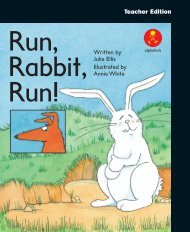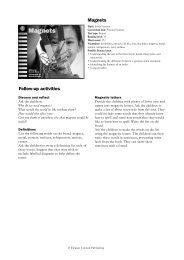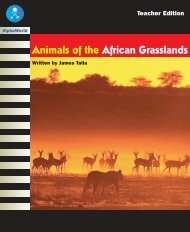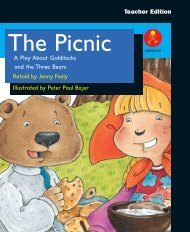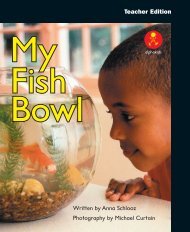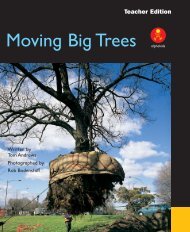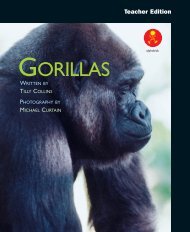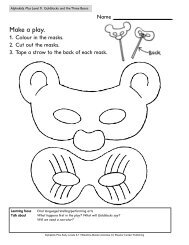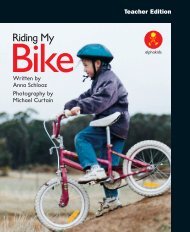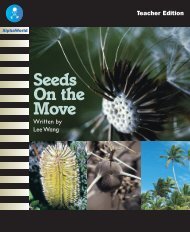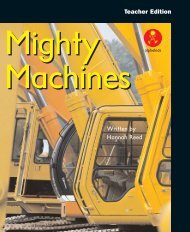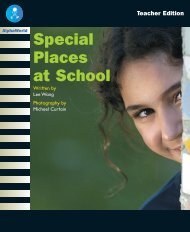Aquarium
Aquarium
Aquarium
You also want an ePaper? Increase the reach of your titles
YUMPU automatically turns print PDFs into web optimized ePapers that Google loves.
Teacher Edition<br />
AlphaWorld<br />
At the<br />
<strong>Aquarium</strong><br />
Written by Keith Pigdon<br />
Photography by Michael Curtain
Published edition<br />
© Eleanor Curtain<br />
Publishing 2003<br />
First published 2003<br />
Apart from any fair dealing<br />
for the purposes<br />
of study, research, criticism<br />
or review, as permitted<br />
under the Copyright Act of<br />
Australia, no part of this<br />
book may be reproduced by<br />
any process, or transmitted<br />
in any form, without<br />
permission of the copyright<br />
owner. Where copies of part<br />
or the whole of this book are<br />
made under Part VB of the<br />
Copyright Act, the law<br />
requires that records of such<br />
copying be kept and the<br />
copyright owner is entitled<br />
to claim payment.<br />
Developed by<br />
Eleanor Curtain Publishing<br />
Text: Jenny Feely<br />
Consultant: Susan Hill<br />
Designed by<br />
Alexander Stitt<br />
Production by<br />
Publishing Solutions<br />
Printed in Hong Kong<br />
ISBN 0 7253 2929 7<br />
Pack ISBN 0 7253 2311 6<br />
(6 Student Books +<br />
1 Teacher Edition)<br />
1 2 3 4 5 6 7 8 9<br />
03 04 05<br />
?<br />
How to use this book<br />
Before reading: Talkthrough<br />
Talk through the book with the children. Encourage<br />
them to predict the text from the pictures and to<br />
think about the information they provide. Direct the<br />
children’s attention to aspects of the text that may<br />
challenge them. Support the children to deal with<br />
these challenges by asking the Talkthrough questions<br />
on each page.<br />
During reading: Observe and support<br />
Observe the children as they read. As needed,<br />
support children by assisting them to discover and<br />
use reading strategies and cues to solve problems<br />
and respond to reading challenges that arise in the<br />
text. Encourage them to monitor their own reading.<br />
Interruptions to the child’s reading should be<br />
minimal and focused on a specified learning need.<br />
After reading: Checking<br />
comprehension, responding to text<br />
To further develop children’s understanding of the<br />
text, select activities found on the inside back cover.<br />
These whole text, sentence and word level activities<br />
reinforce the teaching focus of this book. Assessment<br />
ideas are provided to assist with planning for further<br />
teaching.
Setting the context<br />
Ask: What is an aquarium?<br />
Have you ever been to an aquarium?<br />
What did you see there?<br />
Why do we have aquariums?<br />
Introducing the book<br />
This book is called ‘At the <strong>Aquarium</strong>’.<br />
It tells us about a boy’s visit to an<br />
aquarium and the animals he saw there.<br />
AlphaWorld<br />
At the<br />
<strong>Aquarium</strong><br />
Written by Keith Pigdon<br />
Photography by Michael Curtain<br />
At the<br />
<strong>Aquarium</strong><br />
Written by Keith Pigdon<br />
Photography by Michael Curtain<br />
AlphaWorld<br />
Front cover<br />
Point to the title.<br />
Let’s read it together.<br />
Look at the picture. Where do you think<br />
this boy is standing? What is he looking<br />
at? Can the stingray get the boy?<br />
Why not?<br />
Title page<br />
Where is the title? What does it say?<br />
What does the writing under the picture<br />
tell us?<br />
1
At the <strong>Aquarium</strong><br />
I saw a fish<br />
at the aquarium.<br />
?<br />
2<br />
Talkthrough<br />
On each page the boy tells us about what he saw at the<br />
aquarium. Here he says, “I saw a fish at the aquarium.”<br />
Can you show me where to start reading on this page?<br />
Move your finger to show where to go. What do I do at<br />
the end of the line?<br />
2
3<br />
Observe and support<br />
Does the child match each word on the page as they<br />
read?<br />
Can you read it with your finger? Did you have enough<br />
words? Were any left over?<br />
Gently guide the child’s hand as you read it together.<br />
3
At the <strong>Aquarium</strong><br />
I saw a shark<br />
at the aquarium.<br />
?<br />
4<br />
Talkthrough<br />
The next animal the boy sees is a shark. What will the<br />
boy tell us? Can you check the first word of the<br />
sentence? What does it say? What do you think the next<br />
word is? How did you work that out?<br />
4
5<br />
Observe and support<br />
Does the child recognise the sight words: I, saw, a, at,<br />
the?<br />
Show the child the word on one page.<br />
This word says ‘saw’. What does it look like? How will you<br />
remember it?<br />
Turn to another page.<br />
Can you see the word on this page?<br />
Have the child trace the word as they say it.<br />
5
At the <strong>Aquarium</strong><br />
I saw a crab<br />
at the aquarium.<br />
?<br />
6<br />
Talkthrough<br />
What is the boy doing here? Do you think he will touch<br />
the crab? What might happen? What do you think he<br />
will say in the book?<br />
6
7<br />
Observe and support<br />
Does the child use more than one source of information<br />
when cross-checking?<br />
After the child reads the page: You said… (repeat the<br />
child’s reading). Does that make sense? How do you<br />
know? Does it sound right? Does it look right?<br />
7
At the <strong>Aquarium</strong><br />
I saw a sea star<br />
at the aquarium.<br />
?<br />
8<br />
Talkthrough<br />
Lots of people call this animal a star fish. This boy<br />
knows that it’s really called a sea star. He says, “I saw a<br />
sea star at the aquarium.” Can you find the two words<br />
that say ‘sea star’? How did you work that out?<br />
8
9<br />
Observe and support<br />
Does the child monitor their own reading?<br />
You said, “I saw a sea star at the aquarium.”<br />
How did you work that out? What did you look at?<br />
9
At the <strong>Aquarium</strong><br />
I saw a stingray<br />
at the aquarium.<br />
?<br />
10<br />
Talkthrough<br />
Look at these pictures. They show us a stingray from<br />
the top and underneath.<br />
Can you see the word ‘stingray’ on the page?<br />
What did you look at to work that out?<br />
10
11<br />
Observe and support<br />
Does the child notice if they have made a mistake?<br />
If the child pauses at the point of difficulty:<br />
What could fit there? What can you see on the page that<br />
will help you work it out?<br />
11
At the <strong>Aquarium</strong><br />
?<br />
Talkthrough<br />
This page sums up the rest of the book. It tells us<br />
that the boy saw a lot of animals at the aquarium.<br />
I saw a lot of animals<br />
at the aquarium.<br />
12<br />
Comprehension check<br />
What animals did the boy see at the aquarium?<br />
What is the same about all of the animals that live<br />
at the aquarium?<br />
Should we have aquariums? Why or why not?<br />
12
Responding to text<br />
Children could make a mural on<br />
a window to show the animals<br />
featured in the book. Have the<br />
children draw the featured aquarium<br />
animals and stick them to the window.<br />
Cover the aquarium with blue<br />
cellophane as the water. Ask children<br />
to contribute other animals that could<br />
be found there.<br />
Cover key content words to make<br />
a cloze activity, e.g. “I saw a<br />
_____ at the aquarium.” Children<br />
could make their own aquarium book.<br />
Use words from the text to<br />
highlight the sounds of the /sh/<br />
and /th/ digraphs. Find words with ‘sh’<br />
at the beginning or end. Illustrate<br />
these on cards.<br />
For further literacy activities see<br />
the accompanying book, AlphaWorld<br />
Literacy Learning Activities: Emergent<br />
Reading Levels 1–5. It contains two<br />
reproducible blackline masters<br />
specifically related to this book.<br />
Assessment<br />
Can the child:<br />
➤ control the return sweep when<br />
reading more than one line of text?<br />
➤ explain what an aquarium is?<br />
➤ recognise the sight words: I, saw, a,<br />
at, the?
At the <strong>Aquarium</strong><br />
Topic: Animals around us<br />
Curriculum link: Living Things;<br />
Environment<br />
Text type: Recount<br />
Reading level: 2<br />
Word count: 45<br />
High-frequency words: I, saw, a, at, the<br />
Vocabulary: aquarium, fish, shark, crab,<br />
sea star, stingray, animals<br />
AlphaWorld<br />
At the<br />
<strong>Aquarium</strong><br />
Written by Keith Pigdon<br />
Photography by Michael Curtain<br />
Possible literacy focus<br />
Understanding predictable language<br />
structures and anticipating a different<br />
key word.<br />
Using pictures to cue meaning.<br />
Managing the return sweep.<br />
Summary<br />
This book introduces and names a range<br />
of marine animals found in many<br />
aquariums around the world. The thrill<br />
of the experience of seeing animals closeup<br />
is captured in the pictures. The<br />
colours and behaviours of some animals<br />
adds to the interest level.<br />
AlphaWorld<br />
ISBN 0-7253-2929-7<br />
9 780725 329297



